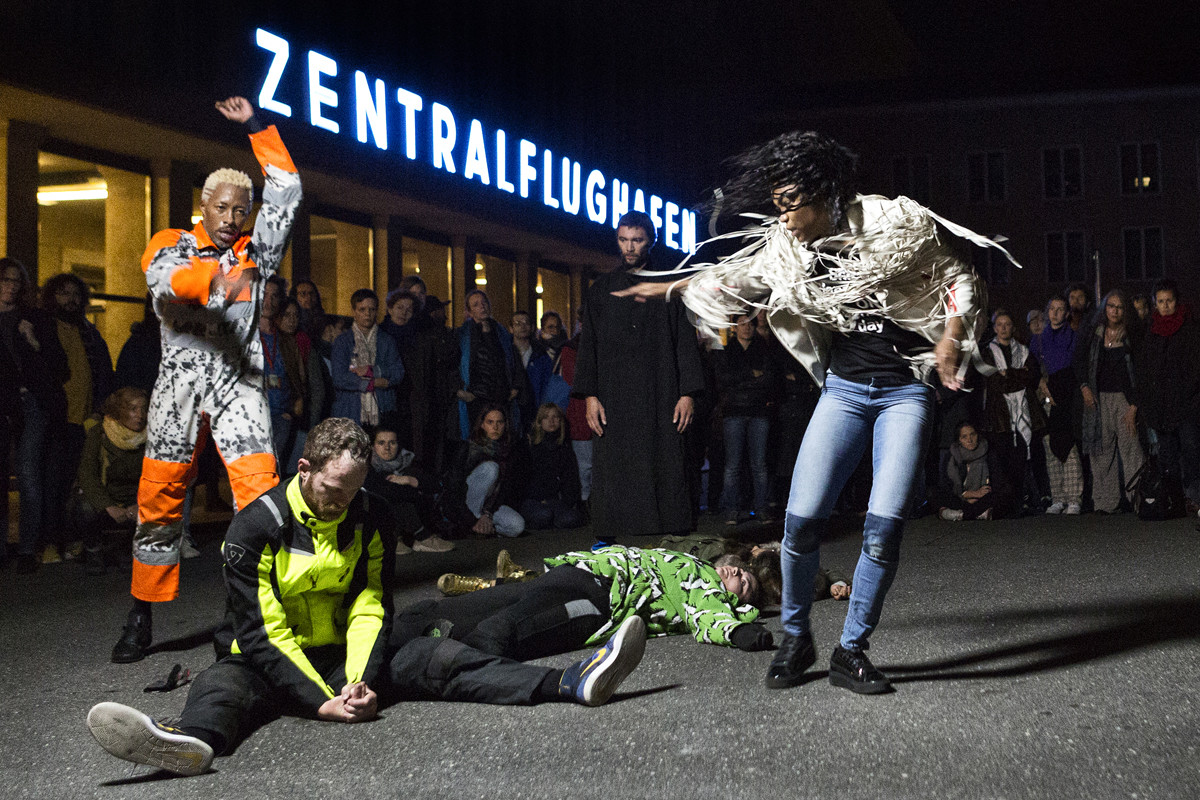Choreography: Boris
Charmatz
danse de nuit
A night-time dance in urban space.
A place in the open air, close to city streets and lights, 6 dancers, minimal set-up. A mind-blowing dance of bodies touching without restraint, even while the mouths of the dancers spout verbal improvisations and a kind of beatboxing without beat. Reflections on the political art of the cartoon, on humor and danger, on the time of drawing compared to the time of dancing, delivered at high speed. Danse de nuit takes place in a parking lot or a semi-enclosed courtyard, an abandoned slab of concrete, an urban ruin. Rain or shine, we dance. A sort of extreme dance for an offbeat public.
“What are those dancers doing, out there, on the concrete, surrounded by all the din of the city? Shouldn’t they be on a stage somewhere, in a theatre, away from the wind, rain and cold? And what exactly is a danse de nuit. Is it a party, procession, demonstration, or a nocturnal battle? Or is it some sort of night-time dance in a round, held in secret, away from the light? Is it the inverse of a daytime dance? A clandestine, hidden away dance. Forbidden territory, perhaps? Following on from the trilogy comprising Levée de conflits, enfant and manger, three vast choreographic structures which made use of a layering effect of actions and constraints, Boris Charmatz comes back to a streamlined formation, featuring dance, speaking and movement at their most condensed level. He also draws upon the intensity of urban dance, but in a way which breaks down or disarticulates all its codes. Continuing, here, his research at the junction between movement and voice, he connects these talking bodies to an amplifier, which has a direct link with the outside world.
The danse de nuit could be seen as a commando group of dancers on the frontiers of the public space, on a mission to push themselves to their limits, reflecting any contradictions they encounter. In group formation or every one for themselves, they attempt to articulate something, anything about our situation, and to make a “state of emergency” come alive in their bodies. A shared sense of intensity develops, circulates. Fragments of words and phrases spring forth... even to the point of blurring, and creating misunderstanding. What becomes apparent is the urgent need to reoccupy this space which has been confiscated by State logic. Situated somewhere between Greek agon and agony, contradictory outburst and funeral march, wild remix and ephemeral dance, danse de nuit can be deciphered as a hastily-scribbled drawing, an unfinished graffiti on a wall, the slogan of which reverberates well into the night.”
Gilles Amalvi In the program of the Festival d’Automne à Paris
The piece is recommended for an informed public.
Production
Musée de la danse / Centre chorégraphique national de Rennes et de Bretagne - Directed by Boris Charmatz. The association receives grants from the Ministry of Culture and Communication (Regional Direction of Cultural Affairs / Brittany), the City of Rennes, the Regional Council of Brittany and Ille-et-Vilaine Departemental Council. The Institut français regularly supports the international touring of Musée de la danse. With the support from the Fondation d’entreprise Hermès within the framework of the New Settings programme.
Text
Texts by Tim Etchells
Glossolalia
realised from dancers’ improvisations, the texts Erasure, Hands Touching, Move and Starfucker by Tim Etchells, the words of Patrick Pelloux in Radio France Inter on January the 8th 2015, writings by Boris Charmatz, quotes and reappropriations from Robert Barry, Marc Gremillon, Bruno Lopes, Didier Morville, Thierry Moutoussamy, Bruce Nauman, Christophe Tarkos, as well as a French counting-out rhyme.
World-Premiere
2 Sep 2016, created at La Bâtie-Festival de Genève
Duration
60min
Coproduction: Théâtre National de Bretagne-Rennes, Théâtre de la Ville & Festival d’Automne à Paris, la Bâtie-Festival de Genève, Holland Festival-Amsterdam, Kampnagel-Hamburg, Sadler’s Wells London, Taipei Performing Arts Center, Onassis Cultural Centre – Athens
Thanks to: Le Triangle-cité de la danse, Rosas, WIELS Centre d’Art Contemporain (Bruxelles), Arnaud Godest, Perig Menez.
With the kind authorization by Tim Etchells for the use of his texts
